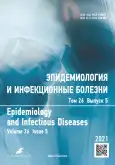Доклиническое исследование токсикологического профиля нового соединения XC221GI
- Авторы: Суханова С.А.1, Проскурина О.В.1, Джайн Е.А.2, Глобенко А.А.2, Багаева М.И.2, Рыдловская А.В.3, Небольсин В.Е.3
-
Учреждения:
- Всесоюзный научный центр по безопасности биологически активных веществ
- Валента Фарм
- Фарминтерпрайсез
- Выпуск: Том 26, № 5 (2021)
- Страницы: 200-213
- Раздел: ОРИГИНАЛЬНЫЕ ИССЛЕДОВАНИЯ
- URL: https://ogarev-online.ru/1560-9529/article/view/108910
- DOI: https://doi.org/10.17816/EID108910
- ID: 108910
Цитировать
Аннотация
Ключевой особенностью COVID-19 является интенсивное вирусиндуцированное воспаление в жизненно важных структурах организма и пространственно-временная дисрегуляция синтеза про- и противовоспалительных цитокинов и хемокинов, что выражается непредсказуемостью клинического течения и высоким риском формирования «цитокинового шторма». Состояние «цитокинового шторма» является патогенетической основой развития грозных осложнений, поэтому актуальной задачей ставится подбор эффективных и безопасных схем терапии, позволяющих управлять вирусиндуцированным воспалением в рамках упреждающей противовоспалительной терапии.
В работе представлена токсикологическая характеристика оригинального низкомолекулярного соединения ХС221GI (1-[2-(1-метилимидазол-4-ил)-этил] пергидроазин-2,6-дион) по результатам доклинических исследований. Полученные результаты свидетельствуют об отсутствии у ХС221GI токсического действия при многократном длительном применении. Все животные хорошо переносили введение соединения, доза без видимого нежелательного эффекта (NOAEL) составляла 30 мг/кг в сутки для собак и 450 мг/кг в сутки для крыс. Установлено отсутствие влияния ХС221GI на форменные элементы крови, систему кроветворения и гемостаза, отсутствие у соединения цитотоксических, мутагенных, генотоксических и канцерогенных свойств, а также анафилактогенного и иммунотоксического действия.
Все известные данные позволяют классифицировать ХС221GI как малотоксичное соединение и считать профиль безопасности нового соединения обоснованно благоприятным.
Ключевые слова
Полный текст
Открыть статью на сайте журналаОб авторах
Светлана Алексеевна Суханова
Всесоюзный научный центр по безопасности биологически активных веществ
Email: ssuhanova46@gmail.com
ORCID iD: 0000-0002-0548-4249
к.б.н.
Россия, Старая КупавнаОксана Владимировна Проскурина
Всесоюзный научный центр по безопасности биологически активных веществ
Email: proskurina_ov@mail.ru
ORCID iD: 0000-0001-5718-3301
к.м.н.
Россия, Старая КупавнаЕкатерина Александровна Джайн
Валента Фарм
Автор, ответственный за переписку.
Email: ekaterina.korsakova@valentapharm.com
ORCID iD: 0000-0003-0283-8598
руководитель группы доклинических исследований АО «Валента Фарм»
Россия, МоскваАлександр Александрович Глобенко
Валента Фарм
Email: Aleksandr.Globenko@valentapharm.com
ORCID iD: 0000-0001-9295-2663
медицинский директор
Россия, МоскваМадина Ибрагимовна Багаева
Валента Фарм
Email: madina.bagaeva@valentapharm.com
ORCID iD: 0000-0002-4577-1832
медицинский советник
Россия, МоскваАнастасия Владимировна Рыдловская
Фарминтерпрайсез
Email: rydlovskaya@pharmenterprises.ru
ORCID iD: 0000-0003-0241-156X
к.б.н.
Россия, МоскваВладимир Евгеньевич Небольсин
Фарминтерпрайсез
Email: nv@pharmenterprises.ru
ORCID iD: 0000-0001-5939-9341
к.х.м.
Россия, МоскваСписок литературы
- Рюленс М., Ваутерс Я. COVID-19: испытания и потрясения для глобального управления в сфере здравоохранения // Вестник международных организаций. 2021. Т. 16, № 2. С. 70–98. doi: 10.17323/1996-7845-2021-02-05
- Tang L., Yin Z., Hu Y., Mei H. Controlling cytokine storm is vital in COVID-19 // Front Immunol. 2020. Vol. 11. Р. 570993. doi: 10.3389/fimmu.2020.570993
- Павликова Е.П., Агапов М.А., Малахов П.С., и др. Эмфизема средостения — специфическое осложнение COVID-19 (клиническое наблюдение) // Общая реаниматология. 2021. Т. 17, № 2. С. 4–15. doi: 10.15360/1813-9779-2021-2-4-15
- Pasrija R., Naime M. The deregulated immune reaction and cytokines release storm (CRS) in COVID-19 disease // Int Immunopharm. 2021. Vol. 90. Р. 107225. doi: 10.1016/j.intimp.2020.107225
- Griffin D.O., Brennan-Rieder D., Ngo B., et al. The Importance of understanding the stages of COVID-19 in treatment and trials // AIDS Rev. 2021. Vol. 23, N 1. Р. 40–47. doi: 10.24875/AIDSRev.200001261
- National Research Council (US) Institute for Laboratory Animal Research. Guide for the care and use of laboratory animals. Washington (DC): National Academies Press (US), 1996. doi: 10.17226/5140
- Буреш Я., Бурешова О., Хьюстон Д.П. Методики и основные эксперименты по изучению мозга и поведения / пер. с англ. Е.Н. Живописцевой; под ред. А.С. Батуева. Москва: Высшая школа, 1991. 398 с.
- Бунятян Н.Д., Васильев А.Н., Верстакова О.Л., и др. Руководство по проведению доклинических исследований лекарственных средств / под ред. А.Н. Миронова. Москва: Гриф и К, 2012. 944 с.
- Van de Veerdonk F.L., Giamarellos-Bourboulis E., Pickkers P., et al. A guide to immunotherapy for COVID-19 // Nat Med. 2022. Vol. 28, N 1. Р. 39–50. doi: 10.1038/s41591-021-01643-9
- Филиппова А.В., Колбин А.С., Вербицкая Е.В., и др. Вопросы безопасности лекарственных средств моноклональных антител, применяемых в ревматологии // Качественная клиническая практика. 2019. № 3. С. 44–52. doi: 10.24411/2588-0519-2019-10082.
- Колбин А.С., Харчев А.В. Безопасность биопрепаратов и малых молекул. Существуют ли различия? // Педиатрическая фармакология. 2013. Т. 10, № 3. С. 17–25.
- Giezen T.J., Mantel-Teeuwisse A.K., Leufkens H.G. Pharmacovigilance of biopharmaceuticals: challenges remain // Drug Saf. 2009. Vol. 32, N 10. Р. 811–817. doi: 10.2165/11316550-000000000-00000
- Strangfeld A., Eveslage M., Schneider M., et al. Treatment benefit or survival of the fi ttest: what drives the time-dependent decrease in serious infection rates under TNF inhibition and what does this imply for the individual patient? // Ann Rheum Dis. 2011. Vol. 70, N 11. Р. 1914–20. doi: 10.1136/ard.2011.151043
Дополнительные файлы






